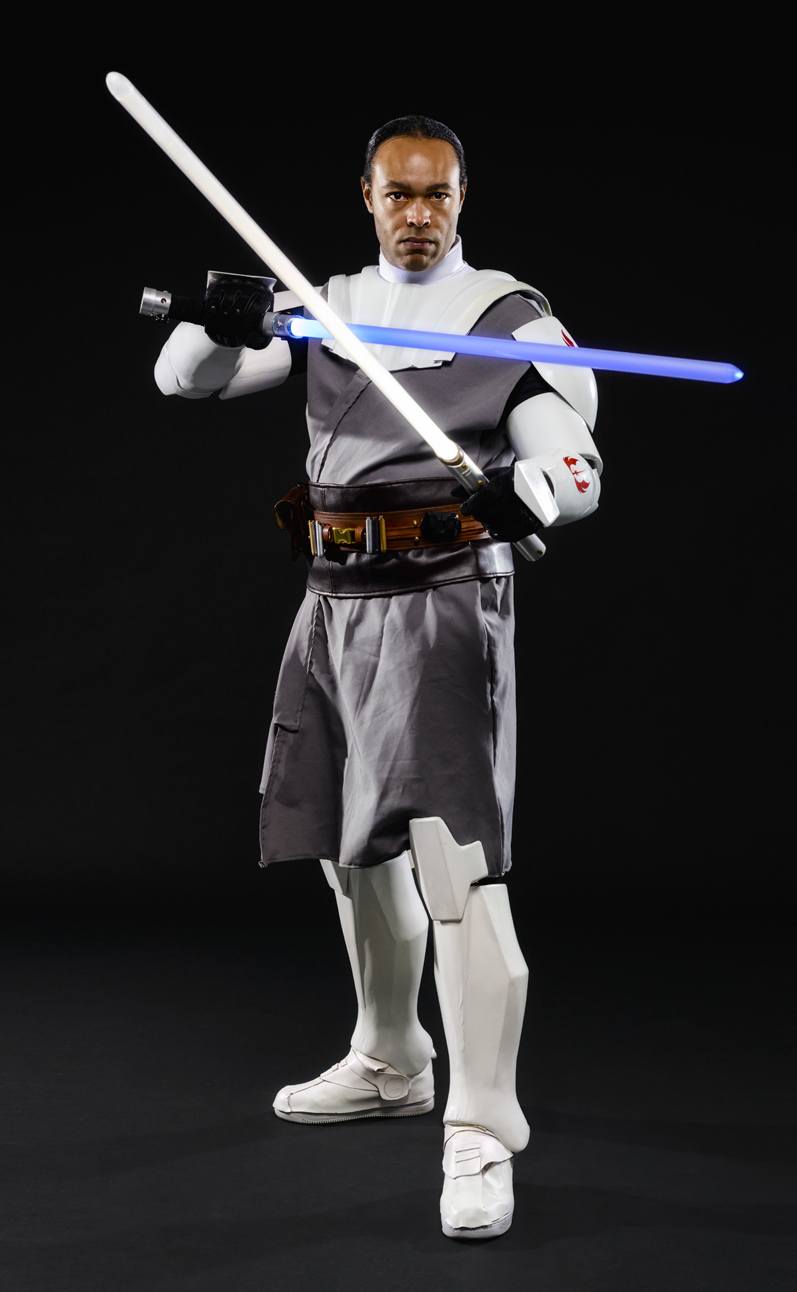
Lots of people like Star Wars. And many would like to be Jedi masters. But one Shoreline teacher and father of two has gone far beyond fandom and become just that: an actual Jedi master. Meet Shaye Whitmer, dad and super awesome teacher at The Evergreen School — when he’s not fighting the Empire or making his own light sabers. Through camps and after-school classes, Whitmer shares his skills with the up-and-coming generation of Star Wars fanatics. With The Force Awakens hitting theaters in December, his Force-channeling skills should be in even higher demand.
How did you find yourself on the Jedi path?
I have always enjoyed swords and such. Pretty much if I could swing it, I was game. When I was younger, I learned to fence. After 15 years of doing that, I learned some kendo (and some other miscellaneous arts in the interim). Between fencing and kendo, I felt pretty well grounded. I learned to smith swords as an apprentice to a Japanese blade smith and a traditional iron smith/farrier.
I learned to make light sabers mostly because I got tired of throwing money at someone for something that I could do myself. Basically, I wanted a fun project to teach myself electronics, and I thought a light saber would be a good thing. They are way more interesting than what you can buy.
Other than how to fight the Empire, what do you teach?
I teach sixth-grade science (basic chemistry, tectonics and astronomy) and fine arts. This is my ninth year at The Evergreen School. Some of the art classes that I teach are Board Game Theory and Design, Spring Fling (catapult construction class) and Wired for Art, where I teach the kids basic electronics: soldering, how to do basic (and some not so basic) circuits.
I hear you teach some pretty sweet summer camps, too.
I do three summer camps. [One is the] Jedi Academy course (probably going to be renamed Saber Academy), where the kids learn some basic forms, footwork, light dueling and a bit of choreography. I also teach advanced Saber/Jedi Academy, where the kids learn to make light sabers from scratch.
What sort of sorcery is this? Do you really teach kids how to make light sabers? Can they defeat the Dark Side?
Week two of Jedi camp has a construction component where kids build their own light sabers. They learn the basic wiring behind it, working with LEDs and different circuit types. Making them is relatively easy if you have a basic design. The wiring is pretty straightforward. There are some tricky parts that I take care of, but nothing that they couldn’t do on their own with guidance.
Kids get to learn basic electronics, volts, amps, battery solutions, how to solder, and how to troubleshoot and problem solve.... For a while, kids lost their way when it came to making things. The maker movement has brought the idea back into the student’s hands.
After kids make these, they just hang them on the wall and stare at them, right?
That’s completely right . . . until I give them lessons on forms and light dueling, which come the day they are finished.
What exactly do you mean by “light dueling”? No one is getting their hand cut off by Darth Vader, are they?
Light contact to the helmet and heavily padded hands. Places where all the safety gear is. I also teach a camp called Scenes from Star Wars, where the students spend some time learning the forms to create realistic fight choreography and light saber battles. All staged, all safe. They work on the delivery of lines, diction and proper emoting as well.
Is this just about weapons or are there greater lessons that they’re learning?
Play fighting is something that all kids will do. This class teaches technique, form, control and discipline. Even though it is largely fictional, the techniques are drawn from other martial traditions. It’s an excellent way to work on hand-eye (and feet) coordination.
The maker component is also important. Kids get to learn basic electronics, volts, amps, battery solutions, how to solder, and how to troubleshoot and problem solve. They get the chance to make a unique tool for themselves. For a while, kids lost their way when it came to making things. The maker movement has brought the idea back into the student’s hands. This is a great way to embrace it.
Have your kids watched the entire Star Wars series? And will you be standing in line with your family on Dec. 18?
The boys have seen the movies. We watched them in order at first (1, 2, 3, 4, 5, 6), then we tried it in machete order (4, 5, 2, 3, 6). Now we tend to watch the phantom edit, which takes all three prequel movies and squishes them into 1.5 hours and cuts out the unnecessary stuff. It’s based on Topher Grace’s Star Wars edit. It’s out on YouTube and is waaaaaaay better. We will see the new movie. We aren’t the got-to-see-the-midnight-showing-type folk. I’ll be content to wait a while.
Lights, saber, action!
Find info on Whitmer’s upcoming camps and classes on his website.











